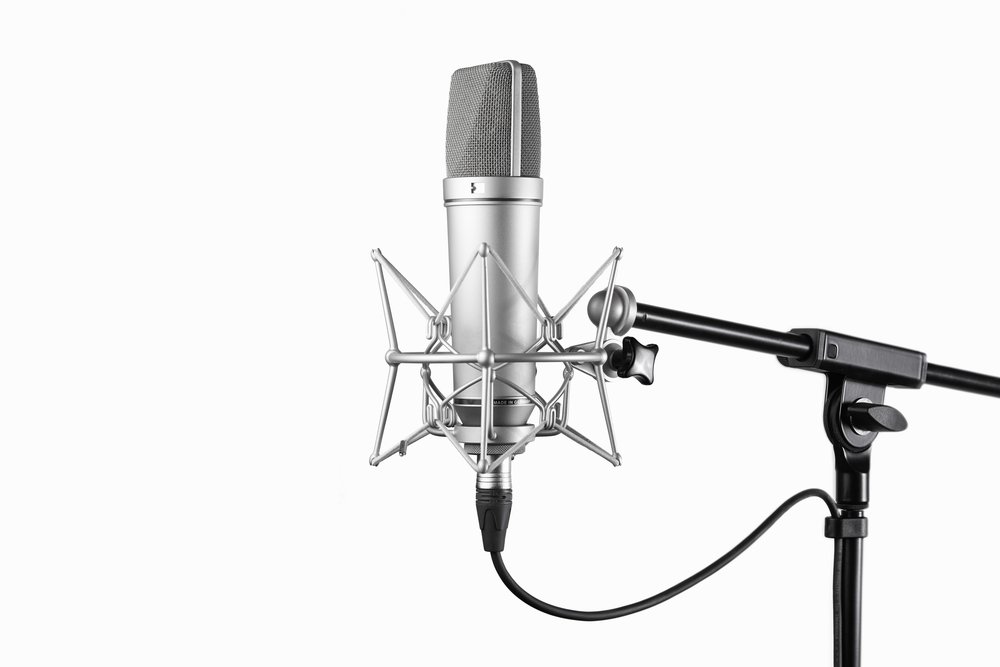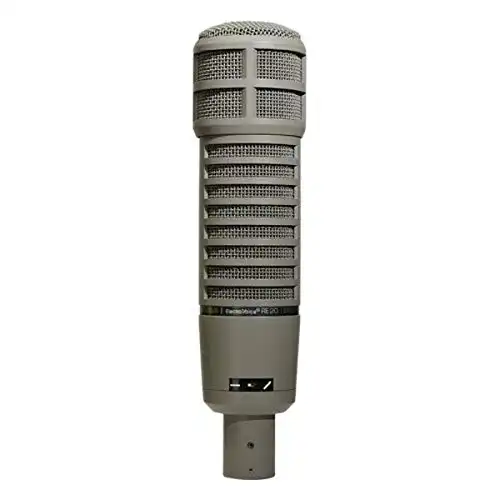The microphone is arguably the most important of all the equipment you’ll need to set up in your recording studio. This is why it’s never a good idea to choose the first (or cheapest) one you come across.
Luckily, many reputable microphone brands create some of the best recording equipment in the world. And, amongst them, you’ll find Electro-Voice. For over 90 years, they have been front runners in the world of recording, and two of their most popular microphones are the RE20 and the RE320.

But what is the difference between these phenomenal mics? And which is better? We’re here to help!
Below, we’ve taken an in-depth look at both the RE20 and the RE320 from Electro-Voice. We’ve investigated their design, sound quality, and price to help you determine which would be best for your recording needs.
Are you ready? Let’s begin!
Table of Contents
RE20
See the Latest Pricing on Amazon
RE320
See the Latest Pricing on Amazon
Design
Before we start looking at the remarkable internal features each of these microphones has, let’s look at their overall design.
Both are sleek, modern-looking mics, and aside from their color, their aesthetics aren’t much different.
The RE20 has a silver-gray finish, while the RE320 has a classic black color. It’s not just the appearance of these microphones that have been thought about, though. Both are constructed from strong, durable steel to give them extra strength and protection against the occasional bump or drop.
A steel mesh grille runs underneath each microphone’s casing, which adds extra protection to the capsule and internal circuitry. The weight of each microphone is the same, with each coming in at 1lb.
This makes them reasonably lightweight, so there’s less of a need to worry about them slowly pulling a boom arm downwards or falling out of a shock mount while you’re recording.
Polar Pickup Pattern
Like all good podcasting or vocal recording microphones, the RE20 and the RE320 operate with a unidirectional pickup pattern. This means they only pick up the sound that’s coming directly in front of them.
This is an excellent feature for podcasting because it automatically blocks out any ambient noise—resulting in crystal-clear vocals without any annoying background sound. It’s also ideal if you plan to record outdoors at any point.
However, this does mean that if you were looking to share a microphone with a co-host or a guest, you’ll either need to pass it between you or sit on the same side of the desk. With this in mind, it’s usually better for each person to have their own microphone.
Variable D-Technology
One of the most remarkable things about the RE20 and the RE320 is that they feature Variable D-Technology. This means that you can switch between recording modes, although there is only one recording direction with the unidirectional pickup.
To explain this in simple terms, this Variable D-Technology means you can record vocals and instruments.
So, while you’re most likely going to stick with the vocal setting when you’re recording a podcast, you’ve got the option to branch out into instrumental recording if you want to. All the while, you won’t have to worry about the expense of purchasing a separate microphone.
Audio quality
Regarding audio quality, the RE320 and RE20 microphones are among the best in the business. The RE320 is known for its lively and open sound, while the RE20 is relatively neutral and flat.
The RE320 microphone also sounds brighter and more articulate, making it great for voiceover and podcasting. The RE20, on the other hand, produces a classic sound suitable for speech/voice. And fun fact, even Radiohead lead singer Thom Yorke has used the RE20 both in the studio and live onstage!
While both microphones are good choices, the RE320 captures more vivid details and is better suited for those who prefer a more vibrant sound.
If you’re struggling to decide between these two, you can check out this video for an in-depth comparison.
Frequency Response Range
As well as making sure that it’s only your vocals appearing on a recording, a good podcasting microphone will also need to transform a range of voices into smooth tones electronically.
Again, both the RE20 and the RE320 are ideal for achieving this. However, there is a slight difference between the two. Take a look at each of their respective frequency response ranges below:
- RE20: Frequency Range 30Hz – 18kHz
- RE320: Frequency Range 45Hz – 18kHZ
As you can see, there isn’t much difference, but as the RE20 has a broader frequency range, it will be able to better register different voices. So, if you’re the host of an interview podcast or panel show, or if you share your hosting role with another person, the RE20 would be the better option.
The RE20’s more comprehensive frequency range would also make it the best choice for somebody with a particularly low voice, as it can pick up treble tones more effectively. It will then produce them into natural, conversational-sounding tones without weird-sounding distortion.
Pop Filter
The inclusion of a built-in pop filter makes both the RE20 and the RE320 stand out from the crowd. If you’re unfamiliar with what this does, let us elaborate a little more.
A pop filter prevents any ‘plosive’ sounds from appearing on your recording. These noises come from words that need harsher pronunciation, such as those beginning with t, p, b, d, and k. Without a pop filter, these words can cause crackling sounds on your recording, and these sounds are referred to as ‘plosives.’
Pop filters also remove any breath sounds from appearing on your recording, and they are pretty useful when you’re recording outdoors. This is because they play a significant role in eliminating wind noise. The integrated pop filter that both microphones feature also helps save a little money when setting up your studio. You won’t have to worry about purchasing a pop filter separately.
Creating a recording studio is expensive, so it’s always a little win if you can save some money somewhere!
Impedance
Sound quality and clear vocals are only part of the game when recording a podcast. You also need to ensure that the audio signal flow between your microphone and your audio interface is well maintained. This is where impedance comes into play.
Both the RE20 and the RE320 have an impedance of 150ohms. This means that the audio signal will be kept strong at all times, regardless of the length of cable you’re using. This makes each microphone ideal for studio recording and live vocal performances.
Connection
The RE20 and the RE320 both feature a standard, 3-pin XLR port. It is used to connect to an audio interface, mixer, or speaker. This is a tell-tale sign of a good-quality microphone, as it allows you to establish a strong connection at all times.
However, there is a slight downside to this, as USB ports are becoming increasingly popular as new recording equipment is introduced. However, it’s not a massive issue, as XLR connections have been around for many years and are unlikely to be entirely phased out any time soon.
Price
It’s fair to say that each of these microphones sits at the higher end of the price scale, so they aren’t the best choice for anybody trying to stick to a smaller budget. However, there is still a bit of a price difference between them.
The RE20 is the more expensive option, currently at around $100 more than the RE320. However, prices fluctuate all the time, so they may become more evenly matched in the future.
User experience
Both models have unique benefits that make them ideal for different purposes. Here, we’ll compare the two models in terms of their user experience to help you decide which one is right for you.
The RE320 is an excellent option if you’re looking for versatility. It can be used for various purposes, from podcasting to radio to different types of music. Some users find that the combination of the two microphones provided just the right amount of versatility they were hoping for.
The 320 is also known to be brighter than other RE models, so it doesn’t require as much gain. This makes it a great option if you’re operating on a budget. However, some users find that the sound quality isn’t as good as other models in the range.
According to users, the 20 is a good option if f you’re looking for a microphone that will give you great results for podcasting. But if you want to operate on a budget, the 320 is a good choice too.
Conclusion
Trying to pick an overall winner between the RE20 and the RE320 is something that turns out to be virtually impossible. Both are evenly matched in design, durability, sound quality, and impedance. So, to determine which is best, you’ll have to look at your podcast’s format and the budget you’re working with.
If you’re looking for a great quality microphone for solo podcasting while still wanting to stay within a reasonable budget, we recommend going for the RE320. You’ll still be able to produce fantastic audio, but you’ll pay around $100 less. If budget isn’t too much of an issue for you, we’d say go with the RE20.
Again, there isn’t much difference from the RE320, but you are offered a slightly more comprehensive frequency range. This makes it a better option for naturally lower-voiced podcast hosts or interviewing various guests each week. If you don’t have any concerns over how much the RE20 costs, then it would be worth investing in a couple to trick your studio out.
Whichever microphone you decide to go for, we’re confident you’ll be super impressed by the quality of your recordings.


